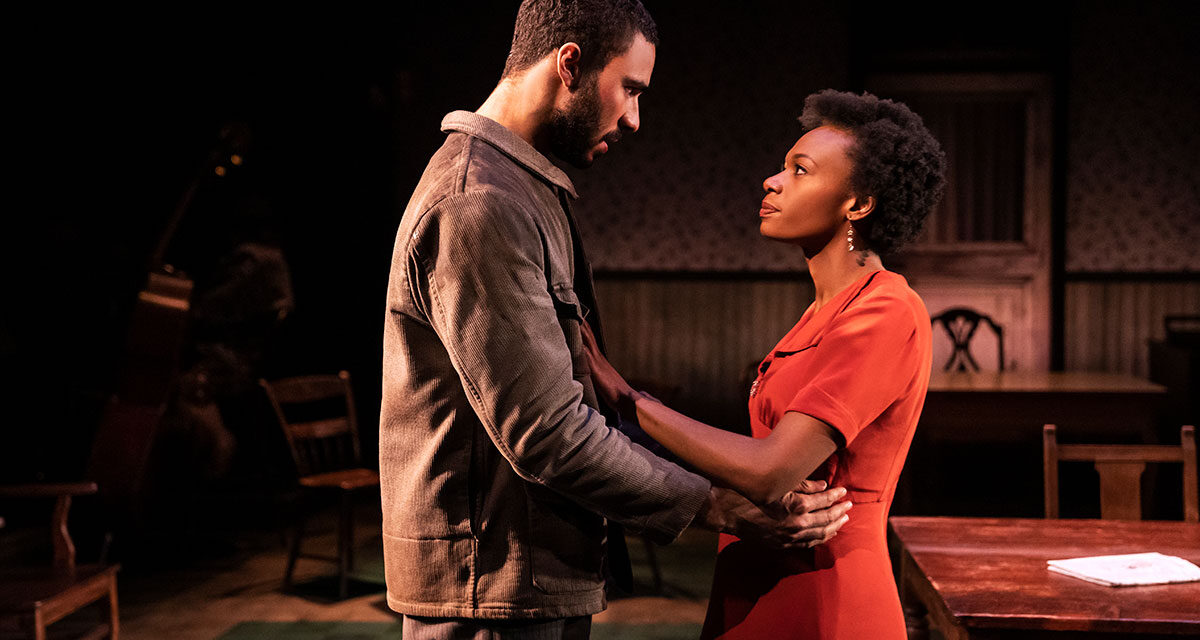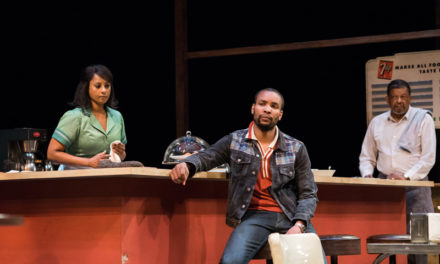People say that trains often make interesting settings for drama since you have people from various backgrounds put together in a single setting. Well, you can also add guesthouses to that list. Girl From the North Country, which recently reopened on Broadway at the Belasco Theatre, tells the story of a guesthouse in Minnesota circa 1934 and of the many residents and boarders who come and go throughout the winter. Set to the soulful folk tunes of Bob Dylan, the musical written and directed by Conor McPherson, captures the lives of midwestern Americana during the Great Depression, when many struggled to get by. The second show after The Times They Are a-Changin’ to use the music of the great midwestern musician, Girl From the North Country proves the greater of the two. It opts for whichever songs convey the tone of the show over which are most well-known. Yes, it’s a musical of sadness and heartbreak, but it digs deeps into the human spirit to provide a powerfully cathartic experience.
Girl From the North Country essentially consists of a series of vignettes, snapshots into the lives of the various people staying at the boardinghouse and their woes. The only through lines comes from the family running the house, the Laines. Nick Laine (Jay O. Sanders) tries to hold his family together, consisting of his wife Elizabeth (Mare Winningham), suffering from some sort of dementia, and their two kids, Gene (Colin Bates) and Marianne (Kimber Elayne Sprawl). With the threat of foreclosure looming above them, Nick makes increasingly brash decisions. These range from trying to get Gene a job he doesn’t want, to getting adoptive daughter Marianne to wed elderly shoemaker Mr. Perry (Tom Nelis). But this plot merely serves as a backdrop for the drama of the people who come to the guesthouse looking for shelter as well as something more.
Each character has an air of mystery about them, and while you do figure out their stories throughout the musical, that air of mystery never totally dissipates. Sometimes this can get a bit frustrating, when not knowing somebody’s situation makes it hard to see the stakes at play. However, Girl From the North Country makes a case that the truth of a person isn’t in their past or their circumstances, but in the validity of what they feel. After all, this is the depression we’re talking about here. Regardless of specifics, people are in bad spots, financially and emotionally.
Who is the girl from the north country? Obviously it’s a song used in the show, but I don’t think it’s a coincidence that the musical has multiple female leads who anchor the plot. Elizabeth Lane is a strong contender. The versatile Mare Winningham provides a modern take on Pierrot, the commedia dell’arte clown who can make you laugh even from the depths of their profound sadness. But another possibility is Elizabeth’s adoptive daughter Marianne, who dreams, or perhaps tries to find the will to dream, of a life for her and her unborn child that doesn’t involve an arranged marriage with the elderly Mr. Perry. Kimber Sprawl personifies the themes of trying to find hope in a hopeless situation at the heart of the show.
The other performers also do a fine job. Robert Joy has a small but pivotal role as Dr. Walker, a less prevalent cousin of the Stage Manager from Our Town, appearing in the plot and then occasionally popping up downstage to give us some information. Joy imbues him with nervous warmth, endearing him to us but also reminding us that 1930s Minnesota was a lot bleaker than turn-of-the-century New Hampshire. Tom Nelis brings pathos to the role of Mr. Perry, alleviating him from what initially seems like the stock part of “much too old suitor” to someone who portrays what it’s like to age and feel dependent on others.
The writing of McPherson also helps, which becomes increasingly self-aware of the conceits of the story as it moves along. Case in point, the show doesn’t talk about race for a while, which may seem like the result of color-blind casting for a show set in a time and place of racial unrest. But no, the casting is absolutely color-conscious. McPherson knows that sometimes writers want to play their hands slowly and deliberately, subverting expectations. The show is all too aware of what everyone faced during and preceding the Great Depression, especially people of color, and acknowledges the reality of the 1920 Duluth Lynchings. The location isn’t just an homage to Dylan’s folk roots, but a reckoning with the themes and subjects he wrote about.
While a great on-stage orchestra provides music from behind the performers, a lot of it is diegetic, performed by the cast on the piano and drum set located in the boarding house. Alright, it’s a bit more believable that a piano would be in a boarding house than a drum set, but scenic designer Rae Smith makes it all work by blending everything into the faded brown color palette of the locale. Lighting designer Mark Henderson helps too, adding sepia lighting to give the set the feel of an old 1930s photograph.
And of course, we have to talk about the man behind the music, Mr. Bob Dylan. Unlike many jukebox musicals, and it feels a little sacrilegious to even refer to this as one, Girl From the North Country doesn’t try to make the plot fit the songs or vice-versa. The songs ostensibly don’t have anything to do with the stories of these folks at the boarding house, but rather serve as emotional lightning rods for their sorrows, their hopes, and their pains. The wonderful thing about Dylan’s music is that it evokes a strong sense of mood. For the show, the story already exists, the music simply makes sure that the emotional beats hit as hard as they can. “Like a Rolling Stone” and “All Along the Watchtower” deserve special mention for involving the full ensemble in some of the most powerful moments in the show.
Dylan himself is known for being notoriously coy about his beliefs and personal life, preferring to let his music speak for itself. So it’s fitting that Girl From the North Country doesn’t have anything to do with his life per se, but still has smatterings of the musician’s trajectory throughout. After all, it’s set in Duluth, Minnesota, the birthplace of Dylan, albeit 7 years before he was born. Gene writes short stories which people mistake as poetry, a nod to Dylan’s lyrics, so poetic they won him the Nobel Prize in Literature in 2016. Dylan’s civil rights songs get a nod with the story of Joe Scott (Austin Scott), who sings Dylan’s song “Hurricane,” the closest the musical comes to a direct adaptation of a song’s story. Dylan wrote the song based on the true story of unlawfully imprisoned black boxer Rubin Carter. The only sections of Dylan’s music that gets short-changed are his anti-war songs, but in a single two-act musical, understandably, you can’t cover the totality of a 60 year career.
The popularity and resonance of Dylan perhaps has less to do with the man himself but rather the feelings his work tapped into, nailing the feelings of counter-culture and alienation prominent in the 1960s. Though Dylan never lived in the 30s, his music can just as easily apply to a time when the United States unemployment rate reached 24.9%. And likewise, Girl From the North Country comes back to Broadway on another parallel occasion where Dylan’s words come as a salve for trying times.
This post was written by the author in their personal capacity.The opinions expressed in this article are the author’s own and do not reflect the view of The Theatre Times, their staff or collaborators.
This post was written by Andrew Agress.
The views expressed here belong to the author and do not necessarily reflect our views and opinions.

















